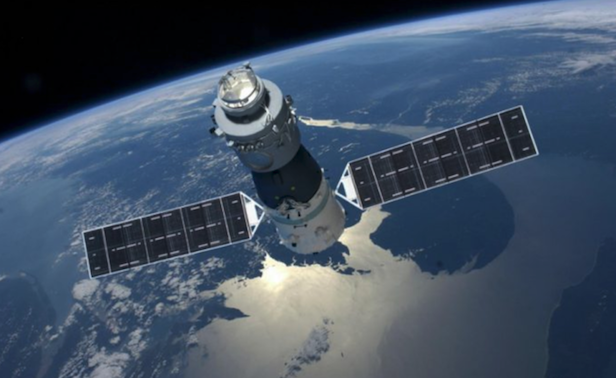Falling satellite: Watch Tiangong-1 plummet through the Earth’s atmosphere
China’s first-ever space laboratory has been predicted to fall to Earth as early as this week, according to Chinese space agency officials

An artist’s impression of the Tiangong-1 space station, which is expected to fall to Earth as early as 1 April. Image credit: CMSA
Tiangong-1, China’s first-ever space laboratory, has been predicted to fall to Earth as early as this week according to Chinese space agency officials – and, weather permitting, there’s the opportunity to see it making one of its final trips around our planet before it disintegrates into a fiery ball on re-entry into our Earth’s atmosphere. Observers have been advised to keep an eye on the sky between the early mornings of 30 March and 2 April, with Easter Sunday being the most likely day that the troubled space station will leave its orbit for good.
Launched on 29 September 2011 from Jiuquan, China, Tiangong-1 – which translates to ‘Heavenly Palace’ – docked with spacecraft Shenzhou-8 in early November of the same year. In June 2012, the Earth-orbiting platform accepted its very first astronauts as part of Shenzhou-9, followed by the Shenzhou-10 mission, which carried a further three astronauts. Both ventures lasted for two weeks. It wasn’t until 21 March 2016 that the Chinese space agency admitted that Tiangong-1 had officially ended its service, culminating in the loss of contact with the space station that had begun to tumble uncontrollably in its orbit around our planet. With loss of communication and no way of regaining it, Tiangong-1 had become nothing more than space junk.
Tiangong-1 is currently circling Earth about every 88 minutes at an average altitude of 134 miles (215 kilometres). In order to catch it before it disintegrates in our atmosphere, you can tune into the Virtual Telescope Project’s free webcast at approximately 12:00 (GMT) on 28 March. Led by astrophysicist Gianluca Masi, the showing will feature live views of the space station in partnership with the Tenagra Observatories in Arizona.
Observers wishing to see Tiangong-1 come crashing through our planet’s atmosphere will require a sighting schedule for their location such as Heavens Above, which can be accessed here. The website allows you to generate a sky map that plots the space station’s path amongst the background stars, the space junk’s brightness can typically range from third magnitude to zero (with the latter being the brightest).
Tiangong-1 is tumbling, so it’s expected that the space station will vary in brightness as it makes its way across the sky and it’s recommended that you check Heaven’s Above regularly for an updated sighting schedule. It’s expected that, as the space lab gets closer to re-entry, times of visibility will change significantly.
Keep up to date with the latest reviews in All About Space – available every month for just £4.99. Alternatively you can subscribe here for a fraction of the price!




